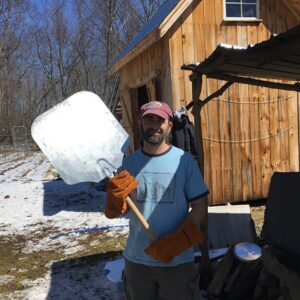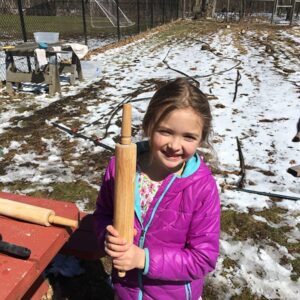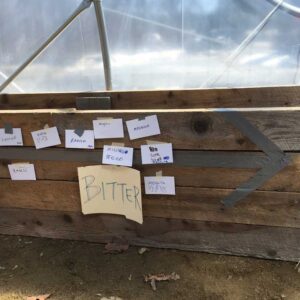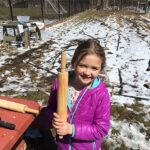by Rose Chernoff, Abundance Farm – Northampton, MA
In this week’s parsha, Tzav, we learn about the rules for how a priest/priestess is to keep the sacrificial fire burning. The instructions are to keep the fire burning all day and all night, and to remove all of the ash in the morning. The fire is to be used for offerings- meat and meal- that is cooked in specific ways…. Sounds old school, I know.
….Enter JOFEE!!!! One of the opportunities that arises on a Jewish Farm is the opportunity to make the words of the torah come to life, or at least seem somewhat more relatable. We can read about fire, and we can also build a fire! We can experience what a fire looks like and feels like, how to start it and tend it and remove the ashes. We can cook with a fire and give gratitude. Experiential lessons give images to the text, and invite participants to enter into a new relationship with this ancient story.
In this vein, we at Abundance Farm crafted a “Make Your Own Matzah” and “Grow Your Own Maror” event last weekend. We created two activities (a Matzah station that I will talk about in brief, and a Maror station that I will go into detail on) that served to make the laws of Passover more experiential and relatable, and invited participants to enter into conversation with these age-old traditions.

“Director of Abundance Farm, Jacob Fine, tends the fire and bakes the matzah!”
During Passover, we are told to eat Matzah, so we built a fire in our cob oven and tended it and moved the coals out. Participants got to try to mix, roll out, and bake their own matzah in 18 minutes or less!
 “Participants mixed, rolled out, and baked their matzah in under 18 minutes!”
“Participants mixed, rolled out, and baked their matzah in under 18 minutes!”
During Passover, we are also told to eat Maror- bitter herbs. So a few weeks ago, during an activity envisioned and lead by Nili Simhai, Director of Outdoor Education at Abundance Farm, teachers in our community planted trays of radish, spinach, lettuce, and mustard greens- the first greens of the season here at Abundance Farm.
 “We grew a variety of greens and invited people to taste them”
“We grew a variety of greens and invited people to taste them”
But wait a second, you might say! What is this talk of different types of maror? When most people at Abundance Farm hear the word “Maror”- Horseradish comes to mind. The white, bitter root….
Rabbi Jacob Fine, the Director of Abundance Farm, suggested I turn to this text to learn more:
The Mishna Pesachim 39a says: ואלו ירקות שאדם יוצא בהן ידי חובתו בפסח. בחזרת. ובעולשין. ובתמכא. ובחרחבינה. ובמרור יוצאין בהן. בין לחין בין יבשין. אבל לא כבושין ולא שלוקין. ולא מבושלין. ומצטרפין לכזית ויוצאין בקלח שלהן. ובדמאי ובמעשר ראשון שנטלה תרומתו. ובמעשר שני והקדש שנפדו: These are the vegetables with which a person discharges his [obligation to eat bitter herbs] on Pesach: with lettuce, and with wild endive, and with garden endive, and with field eryngo, and with bitter coriander; we may discharge [our obligation] with them whether they are fresh or dried, but not [if they are] pickled, boiled, or cooked. [These different vegetables] may combine [together] to [make up the required size of] a kazayit [a specific measure of volume]; and we may discharge [our obligation] with their stalks; and with demai, and with ma’aser rishon from which terumah has been taken; and with ma’aser sheni and hekdesh which have been redeemed.
After reading this text, I feel both liberated and confused. The text states that a bitter leaf or stalk qualifies as maror, but not a root. How come the Horseradish root has become my go-to Maror?
At the same time, how interesting that so many leaves and stems seem like they might actually qualify. It also seems that Maror can be both a cultivated or a wild plant. The definition is both different and more expansive than I thought.
When we return to the text, and ask a question again, a question that we thought we knew the answer to, it both requires us to examine our old behavior and also liberates us to try new things.
 “After tasting the greens, people posted on our chart which greens tasted the most bitter to decide what they would use as their own green maror!”
“After tasting the greens, people posted on our chart which greens tasted the most bitter to decide what they would use as their own green maror!”
In New England, where I farm, it is feasible to grow some of these Maror in our greenhouse in time for Passover, and it is even more feasible to walk out into the pasture, and pick the first, bitter dandelion greens that the earth has sent out- long before us humble farmers can even start tilling the spring fields. By turning to the text, there is an invitation to experiment and search. To explore our own ecosystem and feel empowered to participate.
This experience makes me think about the other traditions that I hold fast to in my life. How can I return to the text, or return to my core beliefs, as an exercise in liberation? And as an exercise in shedding old beliefs and experimenting with new ways of being in this world.
Tradition does not dictate possibility, and liberation can be derived from reexamining the past. May we all seed new interpretations of Passover this year and every year.
__
Rose Cherneff got her start in the farming world as a teenager working at The Food Project in Boston, MA. For the past ten years, she has worked for a variety of production and educational farms. She is looking forward to integrating the community and spiritual goals of Abundance Farm and the JOFEE fellowship into her farming work.
Editor’s Note: Welcome to D’varim HaMakom: The JOFEE Fellows Blog! Most weeks throughout the year, you’ll be hearing from the JOFEE Fellows: reflections on their experiences, successful programs they’ve planned and implemented, gleanings from the field, and connections to the weekly Torah portion and what they’ve learned from their experiences with place in their host communities for the year. Views expressed are the author’s and do not necessarily represent Hazon. Be sure to check back weekly!
